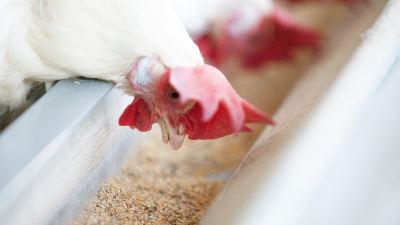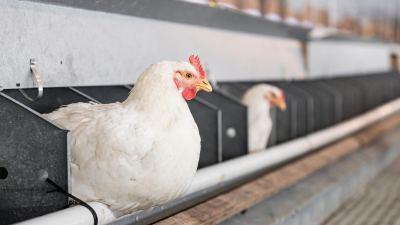Torben Ancker: ZnO ban: An alternative plan?

The European Commission has given pig farmers five years to phase out the use of zinc oxide in feed. Will the rest of the world follow suit? Can farmers find a suitable alternative that maintains the same level of productivity and gut health?
The following is an edited transcript of Nicole Erwin's interview with Torben Ancker, product manager at Hornsyld feed mill in Denmark. Click below to hear the full audio:
Nicole: New zinc oxide regulations are expected to shake up the global pig industry. I'm talking with Torben Anker, product manager at Hornsyld, a privately-owned feed mill in Denmark, where he is responsible for developing pig and broiler feed for Danish farmers. Welcome.
Torben: Thank you very much.
Nicole: Torben, European pig farmers have been given around five years to phase out the use of zinc oxide in pig feed, per the European Commission’s directive in 2017. Since the announcement, what has the response been from feed producers like yourself?
Torben: We knew that the ban would come, and we have tried to find solutions. We started a few years ago, actually. We also know that there is no single product that can replace zinc oxide immediately. Where we stand now is that we are trying to find a good combination of feed components and feed additives, so that we are ready when the ban comes.
Nicole: Why zinc oxide? Why is it so prevalent in pig feed and why is it a problem?
Torben: Zinc oxide is used in Denmark as 2500 parts per million (ppm) when we're weaning the piglets. It works well to reduce diarrhea and E. coli bacteria and so on, and it also reduces the amount of antibiotics necessary when you are weaning. It’s a nice product. The problem with zinc oxide is that when you are feeding the pigs and you put the slurry in the fields, you will have an extra amount of zinc oxide, which is seen as a toxic component in the soil. You increase the amount of zinc over the years. I don't think it will be a problem before maybe 50 or 60 years, but the next generations will have to deal with that. I think it's a good idea to deal with it now.
There are also the health issues because there has been a connection made between zinc oxide and MRSA, which is a disease that some penicillin strains cannot deal with.
Nicole: Methicillin Resistant Staph.
Torben: Exactly. So that's the problem with the zinc.
Nicole: Where else is zinc being used in other industries that it could be significantly contributing to the environment? Is it mainly livestock production that is the culprit, or are there other areas, too?
Torben: I would say when it goes directly into the soil, then it's mainly because of agriculture — the pig industry — which contributes the biggest amount of zinc oxide. The funny part is that the zinc additive used in feed for slaughter pigs is a huge amount compared to the zinc oxide used during the first two weeks of weaning. I would say we could have made more progress if we just reduced the amount of zinc oxide in the feed for the slaughters, and then we still could have some of the zinc oxide for weaning.
Nicole: What are some of the current inclusion levels in feed?
Torben: Normally, we can add 120 milligrams of zinc oxide per kilo of feed. That's a legislation and it's fine. In Denmark, all the feed mills are using phytase. When we are using phytase, we can reduce the amount of zinc oxide. We have already done that, and we have reduced the amount of zinc that goes into the soil.
Nicole: There are discussions floating around that there should be an alternative to the ban. I've heard quite a bit about phytase. What else are you hearing that is promising as an alternative solution?
Torben: I think if we look at alternatives to zinc, it will be a combination of several things. We have to look at the management on farm.
Also, in my opinion, we should look into the sow feeding. It’s much easier to wean piglets weighing 7 to 8 kilos than piglets that weigh 4 to 5 kilos. With sow feeding, we can do something to get a higher milk yield and then have more uniform piglets. That will also help us.
If we look at promising products, the Danish Feed Research Center is now performing some concept tests. There are actually two companies doing quite well. I do not know which company it is, but they are performing quite well. I think that will be very interesting, to see how it comes out, and maybe we can pick some of the elements and put it into our feed also.
Nicole: Do you expect the European Commission to consider some of these alternative proposals, or do you think that it's just set — the ban is going to happen?
Torben: I think the ban will happen and, hopefully, we will have some solution when we reach 2022.
Nicole: I read that phasing out zinc could also lead to higher use of antibiotics. How is that?
Torben: If you look at the Danish pig industry today, if we had to stop using zinc now, it would lead to a higher use of antibiotics. In Denmark, we already use a very low amount of antibiotics compared to other pig countries, like, for example, the Netherlands, Spain and Germany. We have very low use of antibiotics, and our government will not allow us to use more. We really need to find a solution that allows us to still have high-performing pigs with less diarrhea and no welfare problems. That's what we really need to have, because the pig industry in Denmark does not earn that much money, so farmers cannot afford to have reduced production when zinc is banned.
Nicole: The U.S. had just implemented the Veterinary Feed Directive to limit antibiotic use in feed, and a lot of the conversations that I was having went back to Denmark. It's my understanding that Denmark was one of the first countries to impose a feed directive for antibiotic use. It would seem that the possibility for increased antibiotics as a result of banning zinc might encourage an alternative. Or is this a new argument that's coming forward — that removing zinc could increase antibiotics?
Torben: It's well known that if we are taking the zinc oxide away, then we will use more antibiotics. I also think that the use of zinc oxides has become more like a reflex for some farmers. In Denmark, we have some really nice farms — well-managed with a high health status. I think they could take out zinc oxide tomorrow. Maybe 20 percent to 25 percent of the Danish farmers could do that. I don't know, because it's just like an assurance that the problems would not come.
Nicole: Well, these farms that you're talking about, what are some of the management plans they've implemented that would allow them to remove zinc?
Torben: The Danish farmers are quite efficient — they have 35 piglets per sow — and in the last several years, they have been able to build more space for the piglets. I think that’s the reason that some farmers can wean without zinc oxide. There are still a lot of farmers whose animal density is a little bit too high, and maybe they have not been able to develop the pens and all that, so it’s not perfect. But I think 20 percent of farmers would be okay and would be able to do it.
Nicole: What about spraying dried plasma as an alternative in piglet feed? Have you heard much about this?
Torben: In my opinion, that could be a part of the solution, because it's a product that helps the pigs to build immunity. I think we have seen some good results using that in Denmark, but it could be a part of the solution — but not the only thing.
Nicole: I read that there were some concerns about biosafety, particularly during periods of emergence or reemergence of swine diseases in different regions of the world — the recent porcine epidemic diarrhea virus outbreak in North America, for example. With resistance diseases looming in the industry, what kind of research do you expect to emerge in response to the zinc ban? Do you think that there could be new solutions as a result of being forced to find an alternative?
Torben: Yes, I think new solutions will emerge from this. I think we should have started years ago because, while I think we have all the tools, we have not been able to put them together correctly. Also, I think that we have to look at the way we produce. It should not only be a bulk production. But, of course, the consumers have to pay for it.
Nicole: So, do things like a zinc ban force the industry to rethink things? Otherwise, you kind of stay complacent.
Torben: Yeah, they have to rethink how they do things. I think they will develop a lot of tools to handle this situation.
Nicole: From what I've read, it seems like a lot of people know that zinc contributes to gut health, but they don't really know how it contributes. So, if that's the case, how did it end up in pig feed in the first place?
Torben: Zinc has always been seen as a very important building material for the pigs. Danish research has shown that, in the first weeks after weaning, the piglet actually needs large amounts of zinc oxide to develop good gut health. It seems that this has been forgotten. I think the most important thing is that it goes into the soil, and that is a thing that we have to look at, even though the pigs need it.
Nicole: Lastly, if this moves forward, to anticipate whatever the feed industry comes up with to cope with the ban, could it potentially lead the U.S. and other parts of the world in a similar direction?
Torben: I could hope so, because if we could have solutions, then they could be applied in the U.S. also. In Denmark, we haven't been using growth promoters for many years. Maybe it would be good to have a look at that also.
Nicole: What are you looking forward to in the research in trying to find alternatives?
Torben: Reducing zinc oxide is an easy solution, but the feed industry faces a lot of difficult challenges in handling this. On a feed mill like ours, we need the prescription from the vet. We have to deal with that before we can load the feed for the farmer. It's like going to the pharmacy — he needs a prescription. In our production, we need to have thorough cleanings, so we don't carry over zinc oxide to the other feeds. I'm actually really looking forward to getting rid of zinc. All these technical things would be much easier for us. Zinc can be toxic, so I think it would be nice to have a solution with fiber, highly-digestible proteins, milk powder, etcetera. If we could use that, I think we will get better results in the end.
Nicole: I'm talking with Torben Ancker, product manager at Hornsyld. Thank you so much.
Torben: You're welcome.















